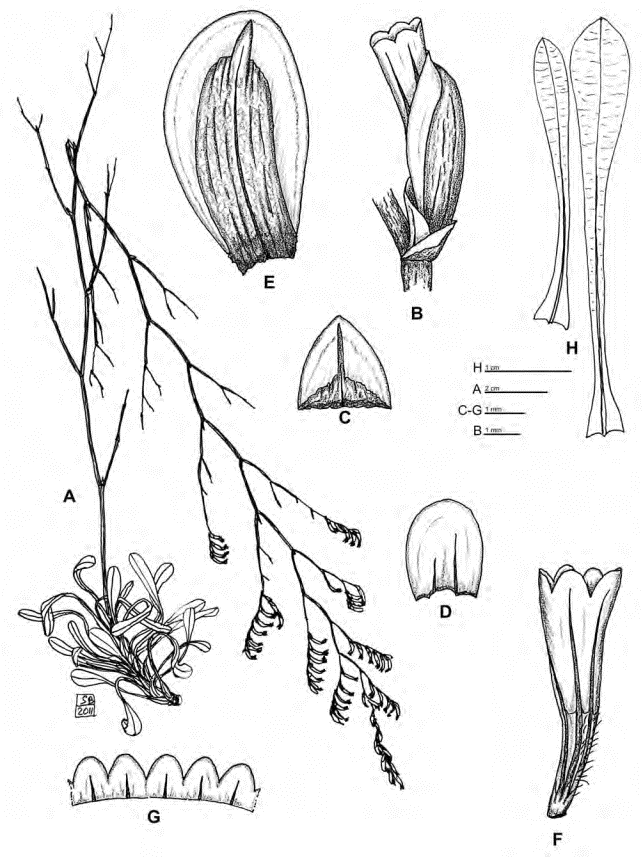Limonium virgatum
1.Limonium virgatum (Willd.) Fourreau (1869: 141) (Fig. 11)
Basionym:-Statice virgata Willdenow (1809a: 336). Type (lectotype, designated by Erben 1978):-SPAIN. “Habitat in Hispania”, s.d., s.l. (B-06189!).
= Statice smithii Tenore (1828: 350). Type:-Not designated.
= Limonium oleifolium Miller, Gard. Dict. ed.8, no. 3 (1768) nom. amb.; Type:-Not designated.
= Statice virgata Willdenow var. tenia Heldreich (1901: Herb. Graec. Norm. no. 1683 cum descriptione) = Limonium tenium (Heldreich) Rechinger fil. (1961: 371). Type (lectotype, designated here):-GREECE. Cyclades: Cycladum insula Tenos, in arenosis maritimis l.d. Angulià, 29 June 1901, De Heldreich 1683 (W-Haláscy!, isolectotypes M!, WU!).
= Statice melia Nyman (1881: 612) = Limonium melium (Nyman) Pignatti (1971: 365). Type(lectotype, designated here):-GREECE. Cyclades: Melos, s.d., d´Urville, s.n. (OXF!).
Description:-Plant perennial, glabrous, forming a sub-shrub 15-60 cm tall, with several erect to ascending stems and a robust tap-root. Caudices 0.5-20 cm long, branched, densely spirally leafy in the upper half. Leaves fleshy, dark green, 30-85 mm long and 4.0-8.5 mm broad, normally flat, verrucate, narrowly spathulate to narrowly oblanceolate, apex obtuse to rounded, mucronate, with one central nerve, gradually tapering into the petiole. Stems 14-50 cm long, flexuous, rugose, branching begins shortly above the base. Inflorescence trullate or obtrullate in outline. Sterile branches several to numerous, 2-5 cm long, straight to slightly flexuous, longer branches divided. Fertile branches 4-12 cm long, straight to slightly flexuous, directed obliquely upwards, forming branching angles of 30°- 45°, branched in the upper half. Spikes 5-80 mm long, straight to arched, directed obliquely upwards to spreading. Spikelets laterally slightly curved near the base, 6.1-7.2 mm long, composed of 1-5 (-10) flowers, remotely to densely arranged with 4-6 per cm; sometimes nearly clustered. Outer bract 1.8-2.8 mm long and 1.7-2.4 mm broad, triangular-ovate, acute; bract margin broadly membranous; central part slightly fleshy, sometimes only at the base, acuminate. Middle bract membranous, 1.7-2.6 mm long and 1.7-2.1 mm broad, broadly oblong to broadly oblong-obovate, rounded. Inner bract 4.9-6.0 mm long and 3.0-3.6 mm broad, elliptic to oblong-obovate, round to broadly acute; bract margin broadly membranous; central part fleshy, 4.0-5.2 mm long and 1.8-2.8 mm broad, oblong, forming a triangular tip, 0.8-1.2 mm long, nearly reaching the upper margin. Calyx 5.0-6.0 mm long, exceeding the inner bract by 1.2-1.8 mm; calyx tube sparsely to densely shortly hairy, with 5 ribs ending above the base of lobes; calyx lobes ca. 0.6 × 0.9 mm, broadly semi-elliptical. Corolla red-violet.
Chromosome number:-2n = 27 (Erben 1978, Artelari 1984a, b, 1989a, 1992, Artelari & Georgiou 2003,
Georgakopoulou & al. 2006 Erben Li-1203, Li-1530, unpubl.).
Distribution:-Widespread througout the Mediterranean region and especially frequent in Greece (Fig. 99).
Habitat:-Rocky coast, salt marshes, sandy soils and ruderal habitats.
Taxonomic remarks:-L. virgatum is apomictic and taxonomically an isolated species.
Basionym:-Statice virgata Willdenow (1809a: 336). Type (lectotype, designated by Erben 1978):-SPAIN. “Habitat in Hispania”, s.d., s.l. (B-06189!).
= Statice smithii Tenore (1828: 350). Type:-Not designated.
= Limonium oleifolium Miller, Gard. Dict. ed.8, no. 3 (1768) nom. amb.; Type:-Not designated.
= Statice virgata Willdenow var. tenia Heldreich (1901: Herb. Graec. Norm. no. 1683 cum descriptione) = Limonium tenium (Heldreich) Rechinger fil. (1961: 371). Type (lectotype, designated here):-GREECE. Cyclades: Cycladum insula Tenos, in arenosis maritimis l.d. Angulià, 29 June 1901, De Heldreich 1683 (W-Haláscy!, isolectotypes M!, WU!).
= Statice melia Nyman (1881: 612) = Limonium melium (Nyman) Pignatti (1971: 365). Type(lectotype, designated here):-GREECE. Cyclades: Melos, s.d., d´Urville, s.n. (OXF!).
Description:-Plant perennial, glabrous, forming a sub-shrub 15-60 cm tall, with several erect to ascending stems and a robust tap-root. Caudices 0.5-20 cm long, branched, densely spirally leafy in the upper half. Leaves fleshy, dark green, 30-85 mm long and 4.0-8.5 mm broad, normally flat, verrucate, narrowly spathulate to narrowly oblanceolate, apex obtuse to rounded, mucronate, with one central nerve, gradually tapering into the petiole. Stems 14-50 cm long, flexuous, rugose, branching begins shortly above the base. Inflorescence trullate or obtrullate in outline. Sterile branches several to numerous, 2-5 cm long, straight to slightly flexuous, longer branches divided. Fertile branches 4-12 cm long, straight to slightly flexuous, directed obliquely upwards, forming branching angles of 30°- 45°, branched in the upper half. Spikes 5-80 mm long, straight to arched, directed obliquely upwards to spreading. Spikelets laterally slightly curved near the base, 6.1-7.2 mm long, composed of 1-5 (-10) flowers, remotely to densely arranged with 4-6 per cm; sometimes nearly clustered. Outer bract 1.8-2.8 mm long and 1.7-2.4 mm broad, triangular-ovate, acute; bract margin broadly membranous; central part slightly fleshy, sometimes only at the base, acuminate. Middle bract membranous, 1.7-2.6 mm long and 1.7-2.1 mm broad, broadly oblong to broadly oblong-obovate, rounded. Inner bract 4.9-6.0 mm long and 3.0-3.6 mm broad, elliptic to oblong-obovate, round to broadly acute; bract margin broadly membranous; central part fleshy, 4.0-5.2 mm long and 1.8-2.8 mm broad, oblong, forming a triangular tip, 0.8-1.2 mm long, nearly reaching the upper margin. Calyx 5.0-6.0 mm long, exceeding the inner bract by 1.2-1.8 mm; calyx tube sparsely to densely shortly hairy, with 5 ribs ending above the base of lobes; calyx lobes ca. 0.6 × 0.9 mm, broadly semi-elliptical. Corolla red-violet.
Chromosome number:-2n = 27 (Erben 1978, Artelari 1984a, b, 1989a, 1992, Artelari & Georgiou 2003,
Georgakopoulou & al. 2006 Erben Li-1203, Li-1530, unpubl.).
Distribution:-Widespread througout the Mediterranean region and especially frequent in Greece (Fig. 99).
Habitat:-Rocky coast, salt marshes, sandy soils and ruderal habitats.
Taxonomic remarks:-L. virgatum is apomictic and taxonomically an isolated species.
FIGURE 11. Limonium virgatum (Willdenow) Fourreau.A) Habit; B) Spikelet; C) Outer bract; D) Middle bract; E) Inner bract; F) Calyx; G) Calyx lobes; H) Leaves. (Habit and leaves drawn from “Korinthos, Akr. Ireo, Brullo & Sciandrello s.n., CAT”, spikelet details from “Thassos, Wanner s.n., M 51689”)
